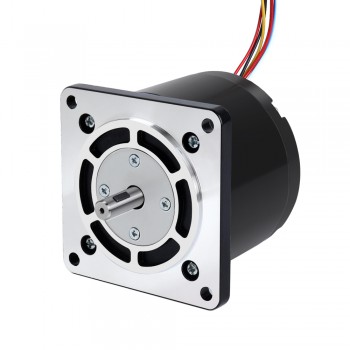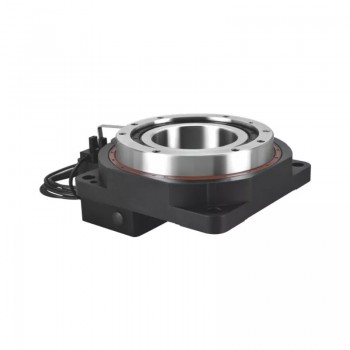1. Working principle of variable reluctance stepper motors
Variable reluctance stepper motors use the change of magnetic resistance to generate torque. There are multiple pole pairs installed on its rotor, each of which is made of magnetic material. The coil on the stator generates a magnetic field through current, and the direction and size of the magnetic field can be controlled by changing the direction and size of the current. When the magnetic field of the stator approaches or reaches the magnetic material of the rotor, these materials will be magnetized into magnetic conduction, so that the rotor generates torque and the stepper motor will rotate.
2. Structure of variable reluctance stepper motors
1. Stator: The stator is the fixed part of the variable reluctance stepper motor, mainly composed of a set of electromagnet windings. The main function of the stator is to generate a magnetic field. When current passes through these windings, an alternating magnetic field is generated inside the stator. The design of the stator requires extremely high stability and strength to ensure the precise control of the motor.
2. Rotor: The rotor is the rotating part of the stepper motor, usually made of steel material or iron core. The magnetic permeability of the rotor is high, and when the magnetic field of the stator changes, the rotor will rotate with the change of the magnetic field. The magnetic field of the rotor is not constant, but changes according to the change of the magnetic field of the stator, and this change enables the motor to be precisely positioned.
3. Excitation system: The excitation system controls the current and magnetic field of the stator winding. Its task is to ensure that the current of the stator winding is energized in a certain way to produce the required magnetic field change. The excitation system ensures the stable operation of the motor by precisely controlling the direction and intensity of the current.
4. Control circuit: The control circuit is responsible for generating and controlling electrical pulse signals that drive the stator winding to generate an alternating magnetic field. Each pulse signal causes the rotor to rotate a fixed angle (step angle), thereby achieving precise position control.
3. Design requirements for variable reluctance stepper motors
1. Motor type selection: Variable reluctance stepper motors have three to five windings and a common terminal connection, forming multiple phases on the stator. The rotor is toothed and made of metal, but it is not permanently magnetized. This design allows the motor to generate rotation by energizing each winding. When the winding is energized, current flows and generates magnetic poles, which attract the metal teeth of the rotor. The rotor moves one step to align the offset teeth with the energized winding.
2. Winding design: The design of the winding is critical to the performance of the motor. The windings should be energized in sequence to ensure that the rotor can rotate continuously. For example, a motor with a four-tooth rotor and three independent windings can form a 30-degree step angle.
3. Drive signal timing: The speed and position of the motor can be controlled by changing the timing of the drive signal. When the windings are energized in sequence, the rotor rotates continuously. This design allows the motor to achieve fast start, stop and reverse functions while maintaining high accuracy.
4. Control circuit design: Stepper motors require complex electronic control. The control circuit should be able to provide appropriate pulse signals to ensure that the motor operates as expected. The design of the control circuit needs to take into account the maximum torque and current limit of the motor to ensure that the motor can operate stably under various load conditions.
5. Cooling design: Since stepper motors generate heat during operation, a reasonable cooling design is required to ensure that the motor does not overheat. The cooling design should take into account the operating environment and expected load of the motor to ensure long-term stable operation of the motor.
6. Reliability requirements: The high reliability of stepper motors is a major advantage because their commutation does not require brushes or physical contact. However, the life of the motor still depends on the performance of the bearings, so high-quality bearings and proper lubrication need to be selected.

4. Main application industries of variable reluctance stepper motors
1. In the field of industrial automation, variable reluctance stepper motors are used in various automation equipment and systems to provide precise position control and motion control. Its high precision and reliability make it an important component in the field of industrial automation.
2. In CNC machine tools, variable reluctance stepper motors are used to drive the movement of workbenches, tools and various mechanical parts. Its precise stepping control capability enables CNC machine tools to perform high-precision processing operations.
3. In printing equipment, variable reluctance stepper motors are used to drive various components of the printing press to ensure the accuracy and stability of the printing process. Its stable performance and reliability enable printing equipment to produce high-quality prints.
4. In the automotive industry, variable reluctance stepper motors are often used to control various electric components, such as electric windows, electric seats, electric rearview mirrors, etc. These applications require motors to have high precision and reliability, and variable reluctance stepper motors just meet these needs.
5. In the home appliance industry, variable reluctance stepper motors are often used to control washing machines, refrigerators, air conditioners and other equipment. Due to its simple structure and low cost, it is suitable for mass-produced home appliances.
Source:https://steppermotor2.hatenablog.com/entry/2025/03/28/185008


